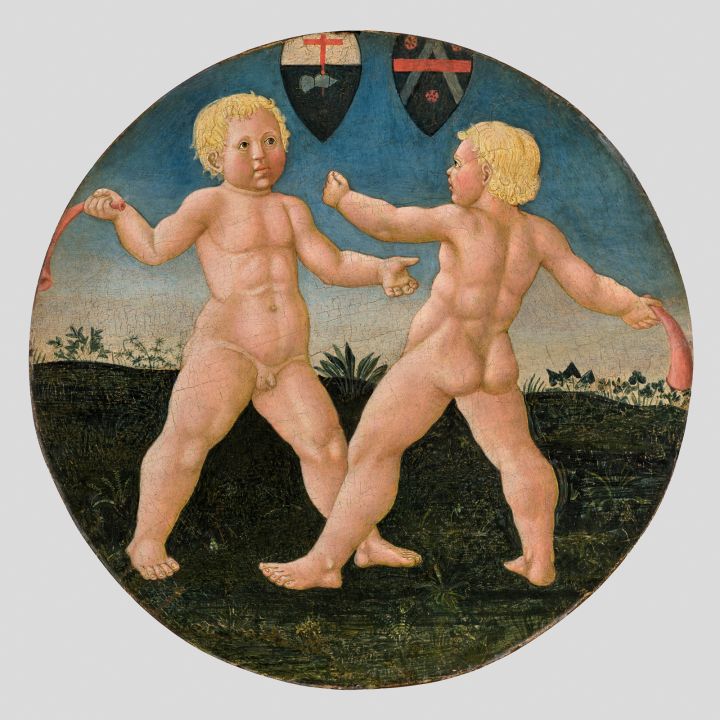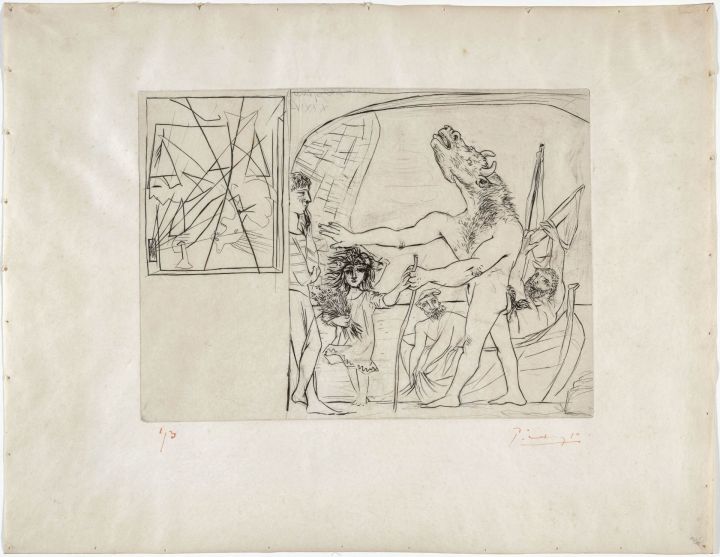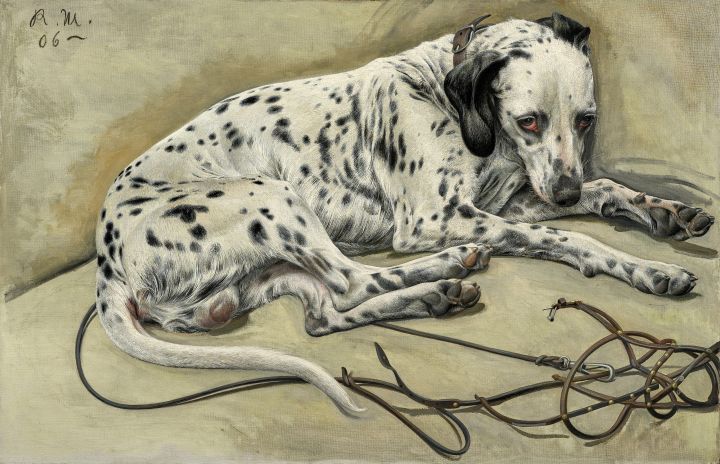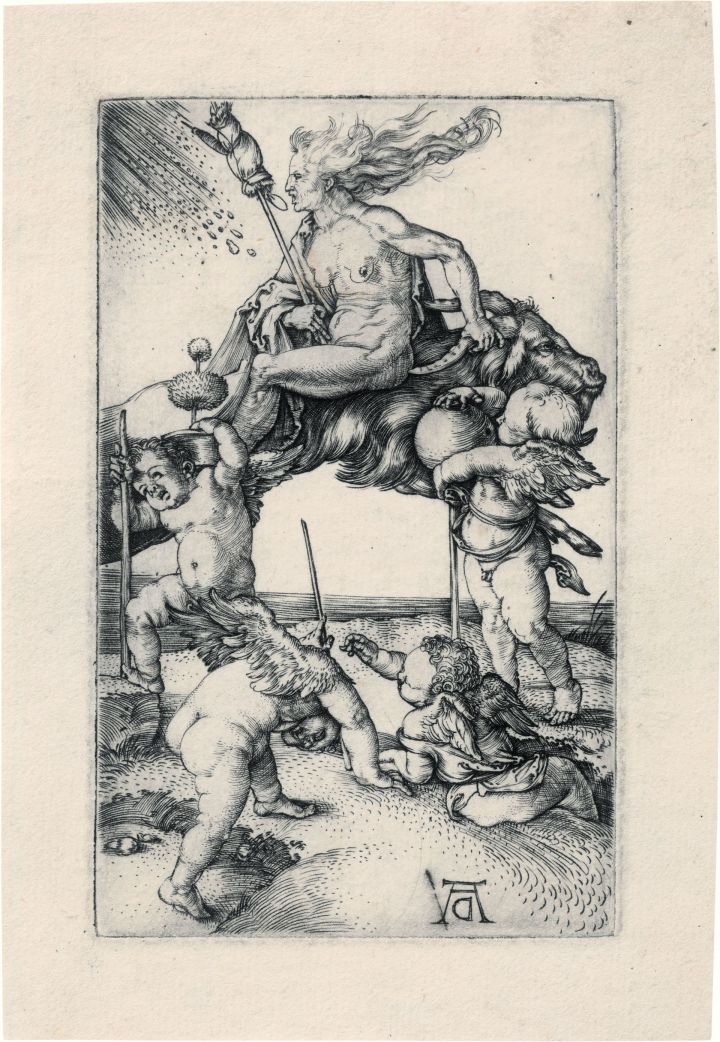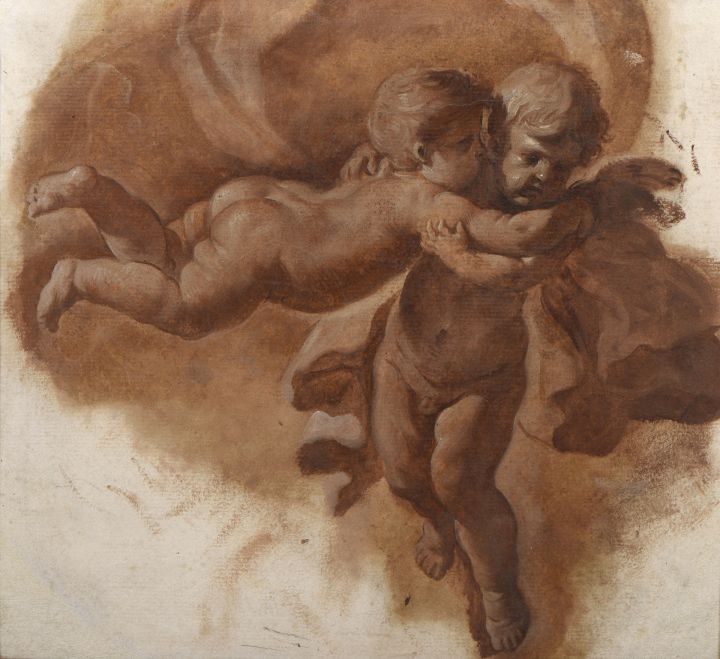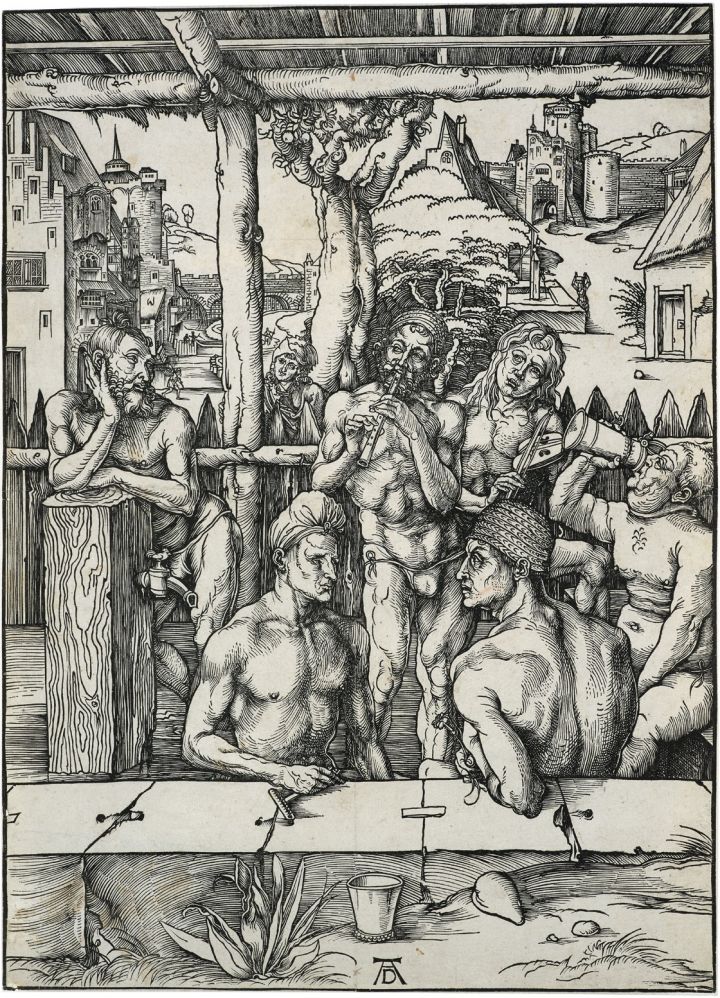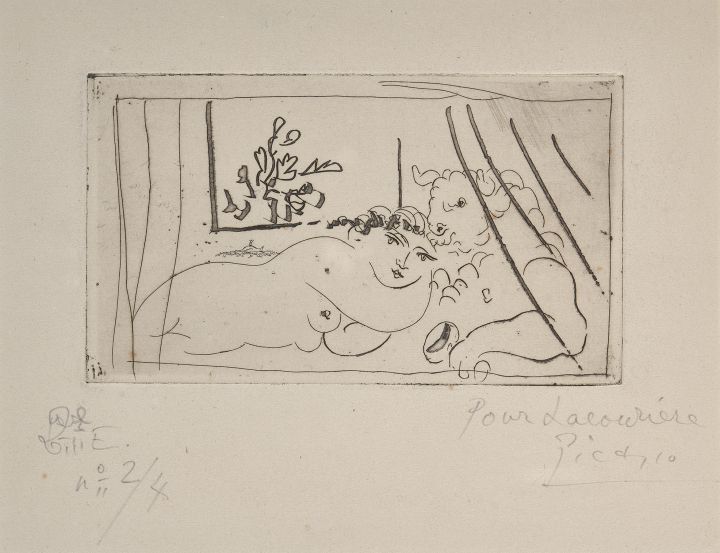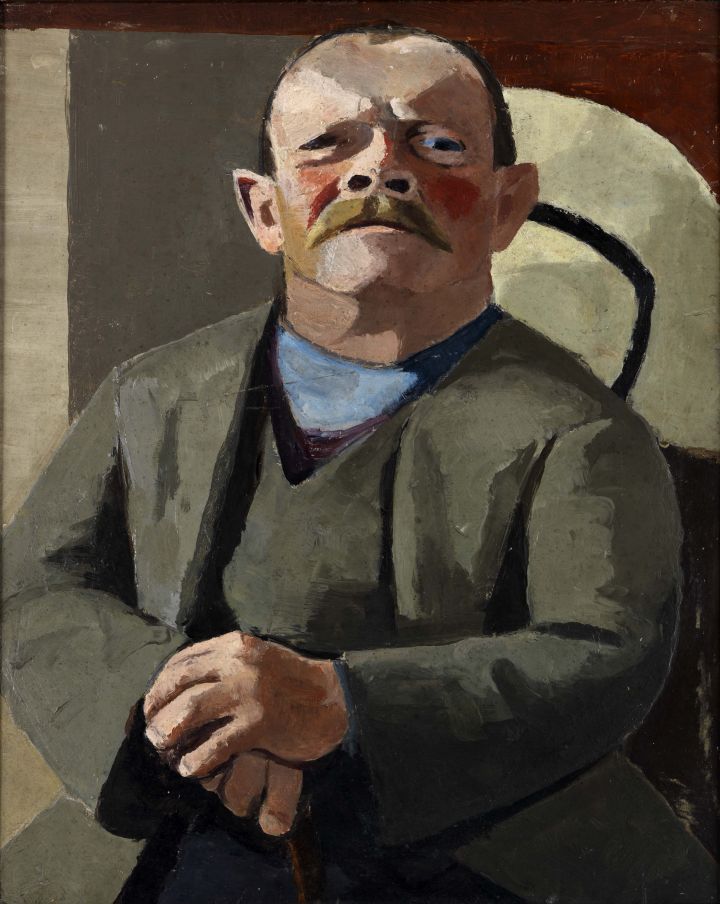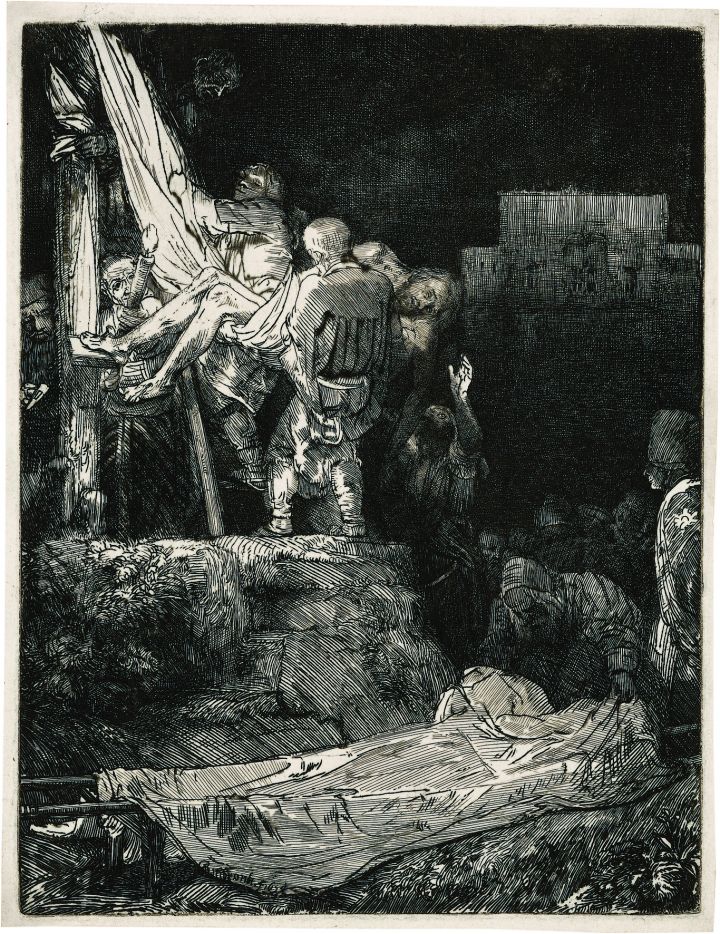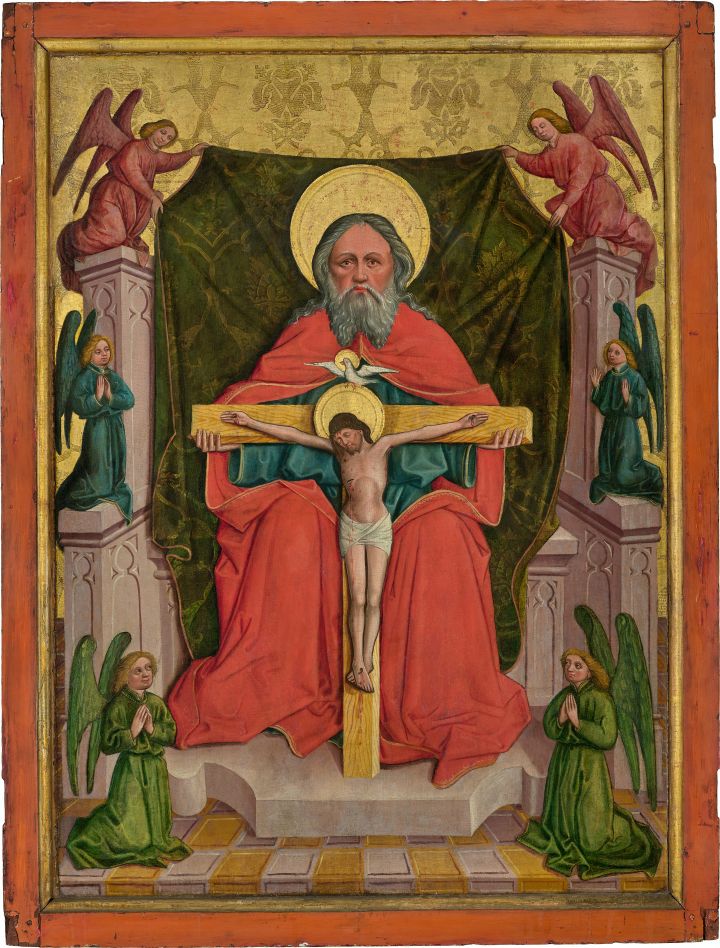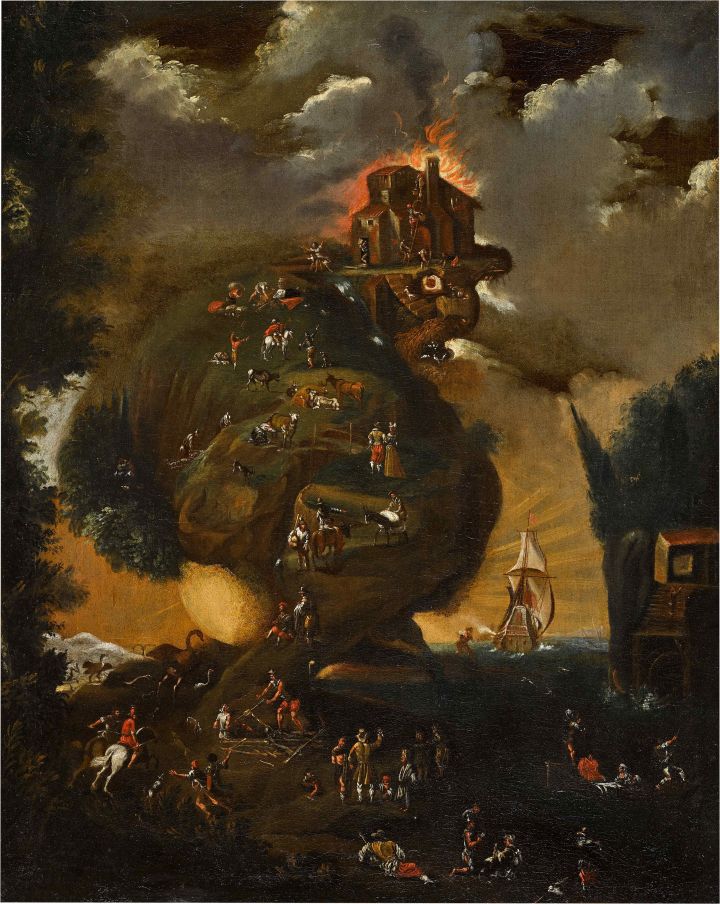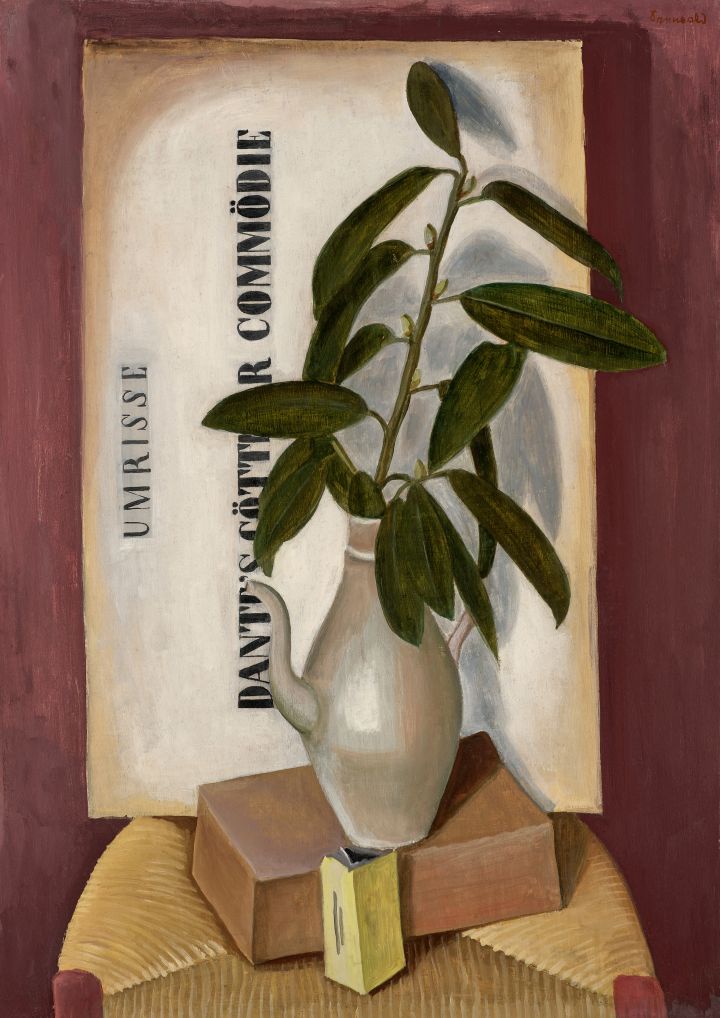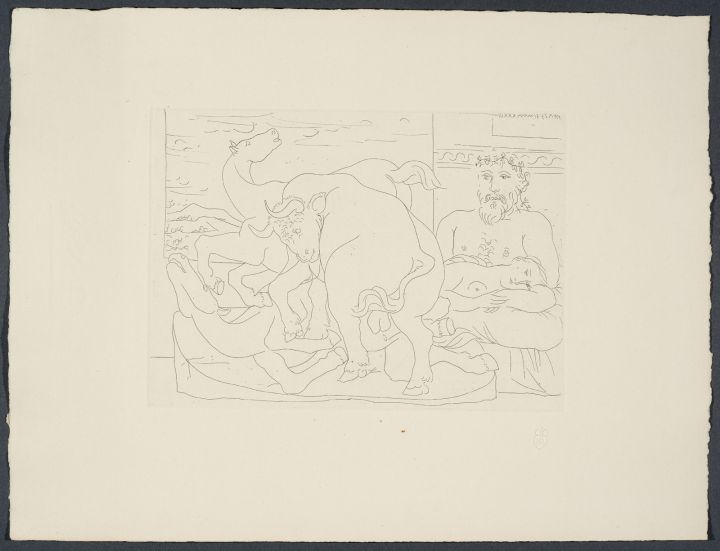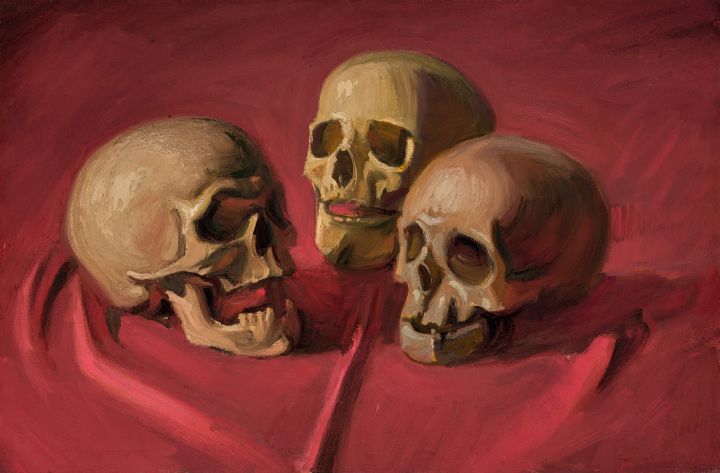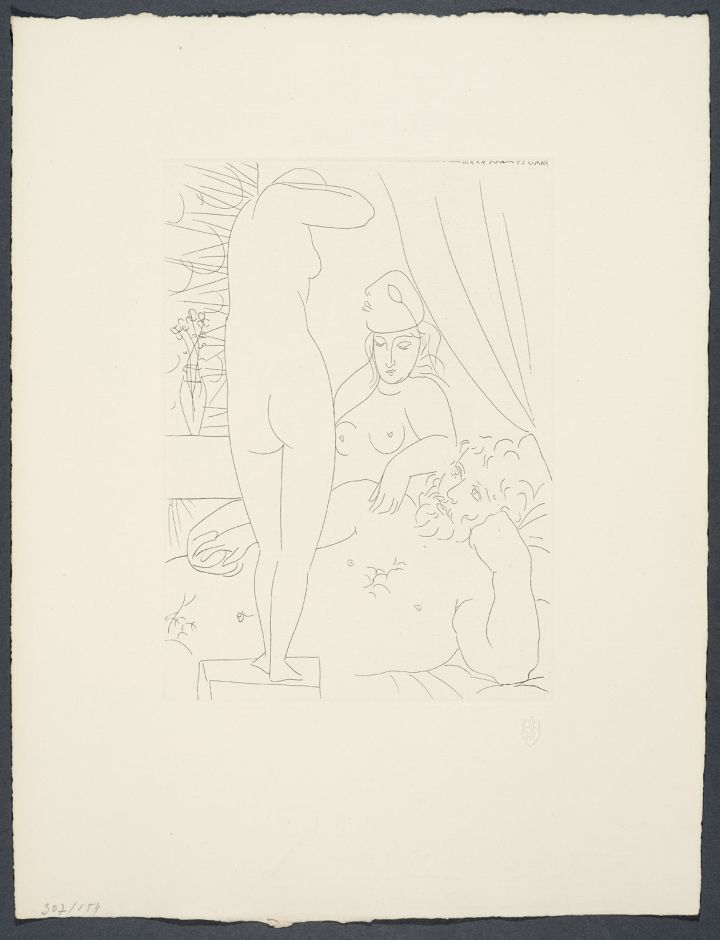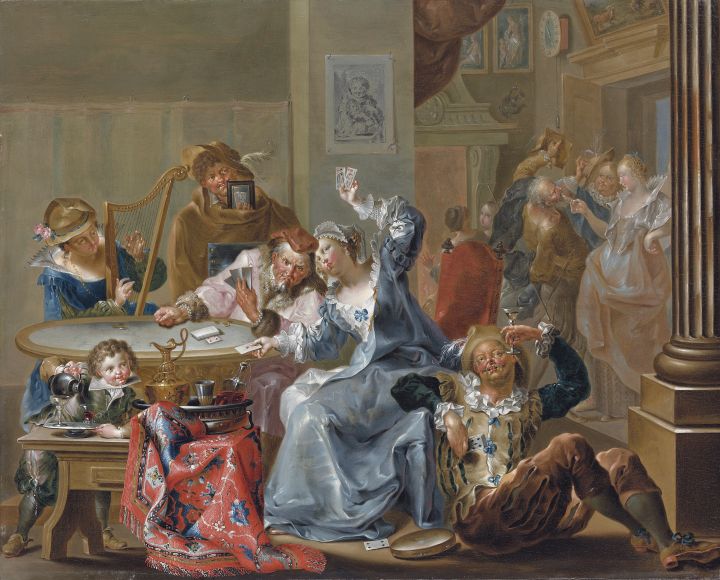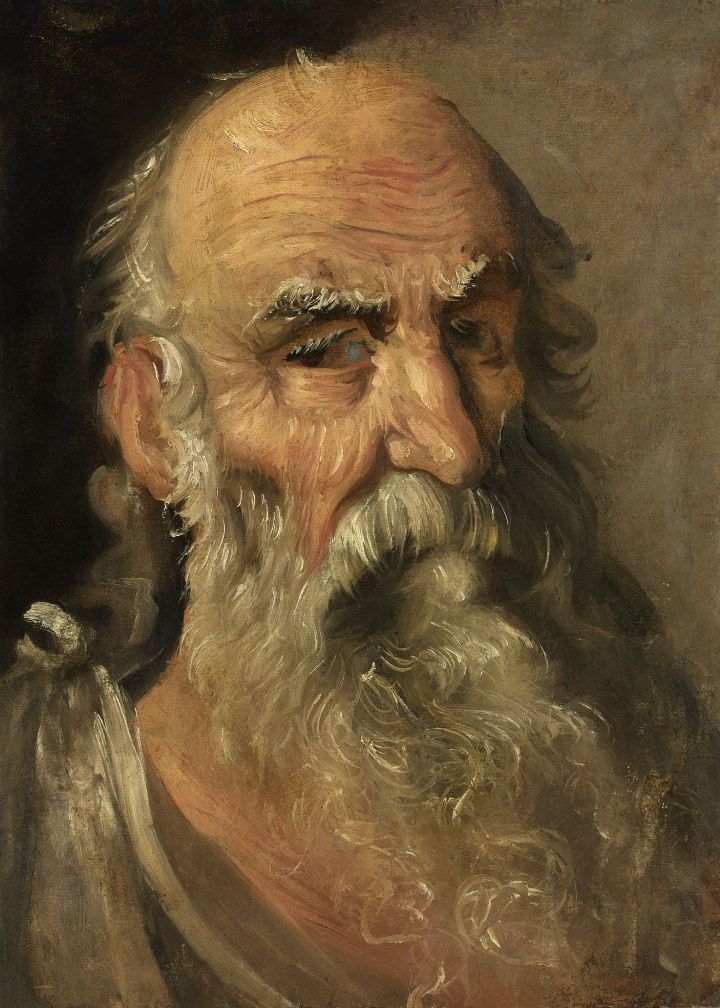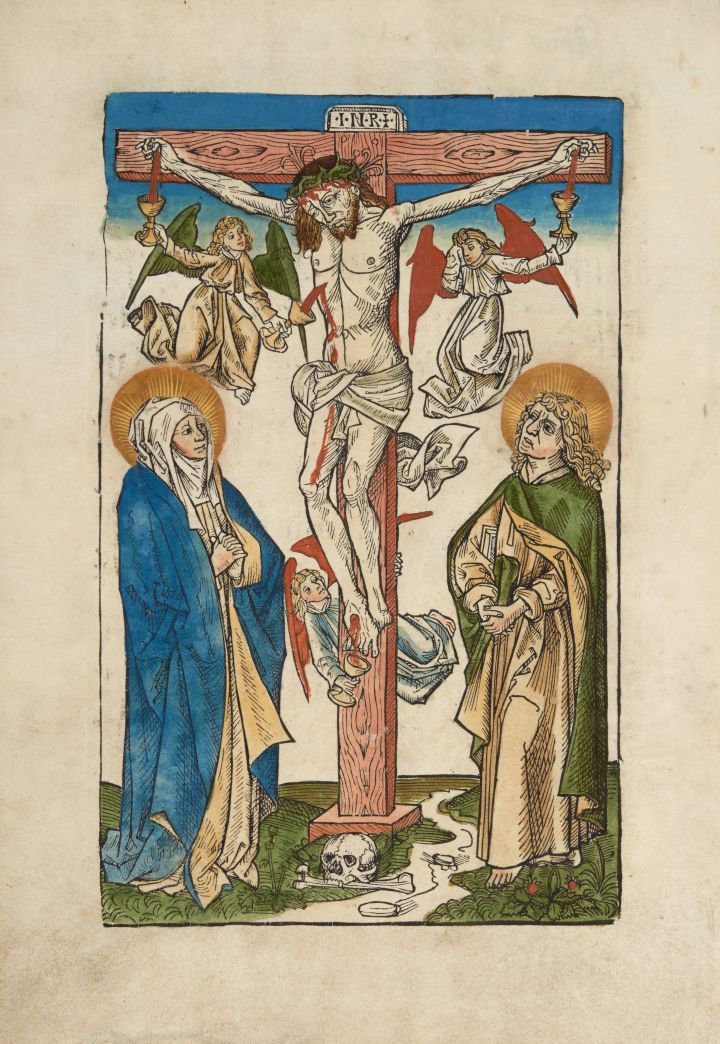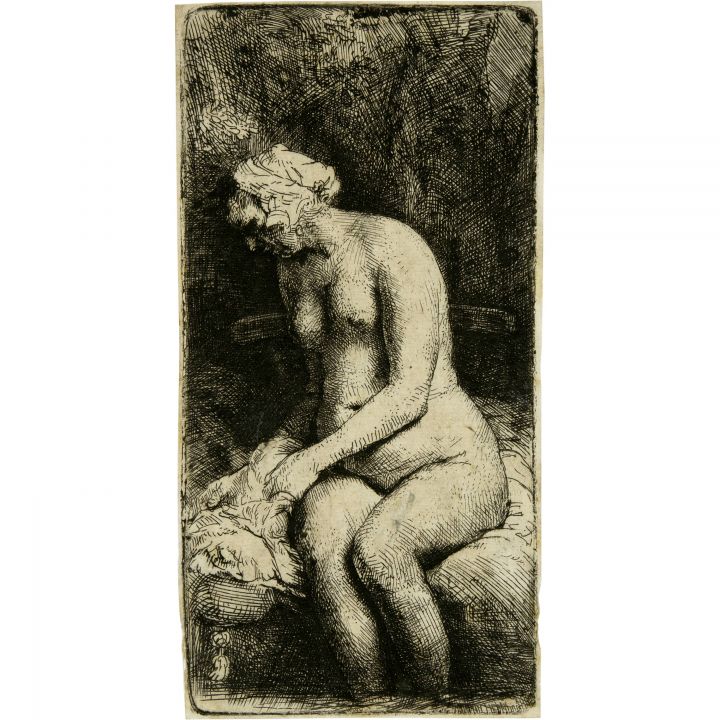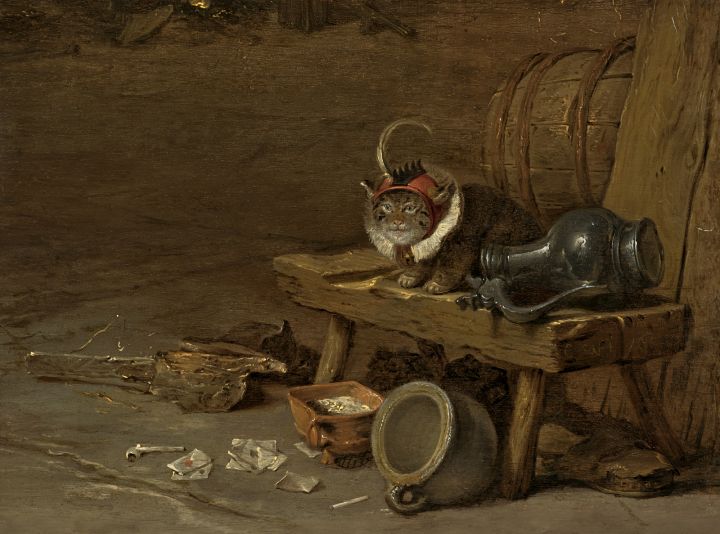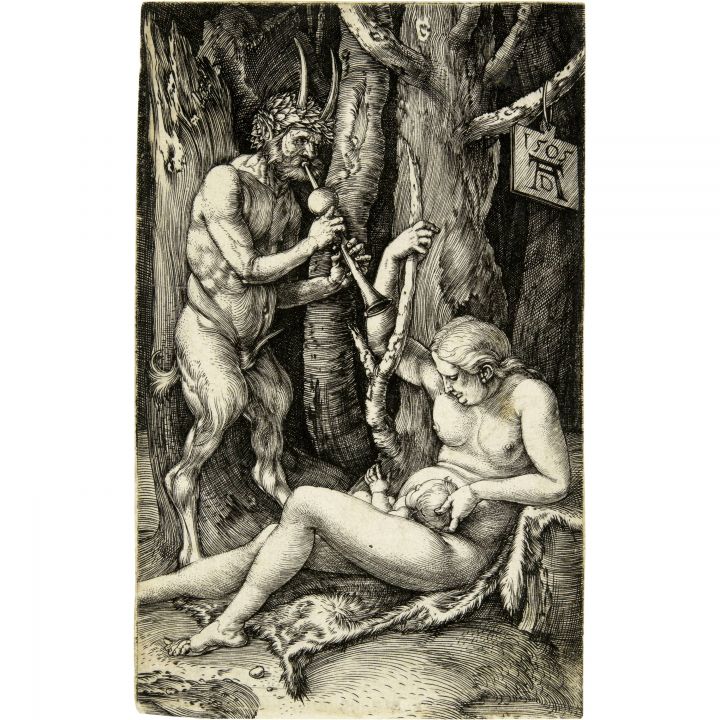Giovanni di Ser Giovianni, Lo Scheggia (1406-1486)
Desco da parto: Two boys at play
tempera and oil on panel, 63.5 cm. diameter
Provenance
Stefan von Auspitz collection, Vienna, by 1910;
Adolf von Beckerath, Berlin;
Anonymous sale, Berlin, Rudolph Lepke, 23-26 May 1916, lot 311 (as Manner of Piero della Francesca);
Emil Weinberger, Vienna;
His sale, Vienna, C.J. Wawra & Glückselig, 22-24 October 1929, lot 451 (as Central Italian (Sienese) School, c. 1480);
Kurt Walter Bachstitz, The Hague, by 1938;
Sold after his death by his wife Lilli Bachstitz, Paris, Galerie Charpentier, 27 March 1952, lot 11 (as Domenico di Michelino);
With The Arcade Gallery, London, by 1953.
Where acquired by Wildenstein & Co., New York, 1953;
By whom anonymously sold, New York, Christie's, 25 January 2012, lot 3, for $482,500;
Where acquired by Fabrizio Moretti, London;
By whom sold, Sotheby's, New York, 19 December 2019, lot 8, for $262,500;
Where acquired by a European private collection.
Literature
C. Brandi, Quattrocentisti senesi, Milan 1949, p. 210 (as Sienese School);
L. Collobi Ragghianti, "Domenico di Michelino," in La Critica d'Arte, vol. VIII, no. 5, xxxi, January 1950, p. 374, note 22 (as Domenico di Michelino);
E. Callmann, Apollonio di Giovanni, Oxford 1974, pp. 58-59, under no. 14 (without attribution);
E. Callmann, Beyond Nobility. Art for the Private Citizen in the Early Renaissance, exhibition catalogue, Allentown 1980, p. 7, cat. no. 5 (as Florentine School, 1460-80), reproduced fig. II;
C. de Carli, I deschi da parto e la pittura del primo Rinascimento toscano, Turin 1997, pp. 120-121, cat. no. 25 (as Florentine School, c. 1450);
J.M. Musacchio, The Art and Ritual of Childbirth in Renaissance Italy, New Haven and London 1999, pp. 130-131, reproduced fig. 123;
E. Fahy, L'Archivio storico fotografico di Stefano Bardini: dipinti, disegni, miniature, stampe, Florence 2000, pp. 40 and 190, cat. no. 296, reproduced fig. 296;
C.C. Wilson, "Leo Planiscig and Percy Straus 1929-1939: Collecting and Historiography," in Small Bronzes in the Renaissance, New Haven and London 2001, p. 267, note 31 (as dated 1460 - 1480).
Exhibited
London, Knoedler House, Great Masters of the 14th-18th Century from the Collection of N.V. Bachstitz Gallery, 's-Gravenhage, 1938 - 1939, no. 1 (as Andrea da Firenze);
Allentown, Pennsylvania, Allentown Art Museum, Beyond Nobility. Art for the Private Citizen in the Early Renaissance, September 1980 - January 1981, no. 5 (as Florentine School, 1460-80).
PRICE
Please contact me
Minotaure aveugle guidé par une fillette, I, from La Suite Vollard
1934
etching on parchment, image size: 24,7 × 33,8 cm; sheet size: 41 × 53,4 cm
numbered and signed in red ink: 1/3 – Picasso
From the edition of 3
PROVENANCE
Collection Walter Kern, Winterthur/Uttwil.
Thence by descent to a private collection, Switzerland
Catalogue raisonné:
Bloch, 222; Geiser-Baer, 434.XIII.a.
PRICE
Please contact me
Dalmatian, 1906
Oil on canvas, 56 x 87 cm
Monogramed and dated upper left: RM/06
- one of the artist's masterpieces
- brilliant brushwork
- psycholigically profound and life-like portrait of a dog
- never offered on the art market before
PROVENANCE
Eduard Staffel, Witzenhausen (a friend of the artist)
thence by descent
Private collection, Germany
PRICE
Please contact me
LITERATURE
Franz Hermann Meißner, Das Werk Richard Müllers, Dresden 1921, pp. 134-136, plate 43.
Corinna Wodarz, Symbol und Eros. Die Bildwelten Richard Müllers (1874–1954) mit dem Katalog des Gesamtwerks [= calatalogue raisonné], Göttinger Beiträge zur Kunstgeschichte, vol 1, Göttingen 2002, no. M 1906.03.
Richard Müller was a fascinating German artist with extraordinary skills. At the young age of 14 he started to work at the Royal Saxon Porcelain Manufactory in Meissen just outside of Dresden. In 1890, at only 16, he was admitted, as one of the youngest students ever, to the Academy of Fine Arts in Dresden. Richard Müller was a shooting star of his time. He received numerous prices including a gold medal at the Paris Exposition and was appointed to a professorship at the Dresden Academy. There he was helping to establish the Neue Sachlichkeit (New Objectivity) movement and was the teacher of Otto Dix and Georg Grosz. Müller's work has been largely forgotten, until relatively recently, because of his ambiguous role during the Nazi era. In 1933 he became a member of the Nazi party and president of the Dresden Academy of Fine Arts. In the same year he supported Otto Dix's dismissal from the Academy. But only two years later Müller was excluded from the Nazi party and expelled from the Academy himself because of "subversive tendencies" in his art. After the war Müller remained in Dresden during the years of Communist rule and suffered for his supposed complicity with the Nazis. He was not allowed to exhibit his work and lived as an artistic and social outcast.
This arresting portrait of a Dalmatian unites a masterly painting technique that approaches photo-realism with a deep psychological understanding that vibrantly brings to live the represented creature.
The Witch
Circa 1505
Engraving, image: 11,4 x 7,1 cm; sheet: 14,4 x 10,5 cm
PROVENANCE
Freiherr von Maltzan [according auction catalogue Galerie Bassenge, Berlin, 28 May 2025, lot 5070]
Galerie Bassenge, Berlin, 26 May 2000, lot 5168
Private collection
Galerie Bassenge, Berlin, 28 May 2025, lot 5070
Catalogue raisonné:
Bartsch 67, Meder 68 Ia/b (of II), Schoch, Mende, Scherbaum 28 Ia/b (of II).
PRICE
Please contact me
Hanni, Hinterbrühl
1925
Oil on canvas, 41,2 x 29,4 cm
Please contact me for the price
PROVENANCE
The artist, until 1996
Marie-Louise von Motesiczky Trust, London
from whom acquired in 2010 through Galerie St. Etienne, New York, by a private collector
EXHIBITED
London, Goethe-Institut, Marie-Louise Motesiczky. Paintings Vienna 1925 - London 1985, 1985, no. 1, illus. p. 65.
Manchester, Manchester City Art Galleries, Marie-Louise Motesiczky. Paintings 1925-93, 1994, no. 1.
New York, Galerie St. Etienne, Marie-Louise Motesiczky, Paradise Lost & Found, October 12, 2010 to December 30, 2010, no no.
Städel Museum, Frankfurt am Main, „Städel-Women“! Women Artists between Frankfurt and Paris around 1900, Frankfurt am Main 2024, cat. no. 75, illus. p. 134 .
LITERATURE
Rilana Vorderwülbecke, Marie-Louise von Motesiczky, or how to re-establish a late artist in the art market, London 1999, p. 31, illus. p. 65.
Elena López Calatayud, Marie-Louise von Motesiczky. Technique and Materials, diploma thesis, Courtauld Institute of Art, London 2005, p. 22, illus. n.p.
Jill Lloyd, The Undiscovered Expressionist. A Life of Marie-Louise Von Motesiczky, New Haven, Conn. 2006, pp. 36, 39, illus. p. 39.
Ines Schlenker, Marie-Louise von Motesiczky 1906-1996, A catalogue raisonné of the paintings, Manchester/New York, 2010, p. 86, no. 8, illus.
Marie-Louise von Motesiczky (1906 Vienna – London 1996) is one of the most interesting Austrian painters of the twentieth century. Her great artistic talent was discovered by Max Beckmann who encouraged her to become a painter. When the Nazis came to power her stella career came to an abrupt end.
Marie-Louise von Motesiczky was from a wealthy Austrian-Jewish family that among many others was friends with Johannes Brahms, Johannes Strauss, Hendrik Ibsen, Franz von Brentano, Hugo von Hofmannsthal, Sigmund Freud and Oskar Kokoschka.
After studying painting in Vienna, The Hague, Paris and Berlin, she became Beckmann's master student at the Städelschule in Frankfurt am Main in 1927/28. In the following years until the rise of the Nazis she created a number of masterpieces which today are in museums like the Albertina, Vienna, the Tate, London, or the Stedelijk Museum, Amsterdam.
After Austria's „Anschluss“ in 1938 Marie-Louise's hasty escape safed her life. Her brother Karl, who refused to leave his homecountry, was killed at Auschwitz. Marie-Louise von Motesiczky fled together with her mother to the Netherlands and soonafter to England where they settled in Hampstead, London. There she met Oskar Kokoschka again and made acquaintance with the writer Elias Canetti. The latter became a friend, lover and companion for over three decades. Canetti dedicated a collection of aphorisms to 'Marie-Louise' and she painted a portrait of him which today is in the National Portrait Gallery. In 1943, Motesiczky joined the Artists’ International Association and took part in several of their exhibitions. The following year, Motesiczky’s first solo exhibition in London took place at the Czechoslovak Institute. Two solo exhibitions in The Hague and Amsterdam in 1952 were followed two years later by one at the Städtische Galerie in Munich and one at the Beaux Arts Gallery in London in 1960. The first success in her native country came in 1966 when the Wiener Secession staged a large solo exhibition which subsequently traveled to Linz, Bremen and Munich.
The artistic breakthrough in the United Kingdom came with the major solo exhibition at the Goethe-Institut in London in 1985 which achieved enormous critical acclaim. By the time the Österreichische Galerie im Belvedere in Vienna held a retrospective exhibition of Motesiczky’s work in 1994 the artist had already established her reputation as one of the most important female Austrian painters of the twentieth century.
Two women waking up - Deux femmes au réveil
1959
Linocut in light caramel, dark brown and black on „Vélin d'Arches“-paper
Image: 53 x 64 cm, sheet: 62 x 75 cm
Signed below right in pencil: Picasso
An artist's proof apart from the numbered edition of 50
With full margins
Catalogue raisonné: Bloch 925; Baer 1249 II Bb
PRICE
Please contact me
The Young Christ adored by Saint John the Baptist, 1534
signed lower left with the artist's device of a winged serpent with elevated wings, and dated: 1534
oil on panel, 35.2 x 23.2 cm.; 13⅞ x 9⅛ in.
Please contact me for the price!
Provenance
(probably collection M. Benito Garriga, Madrid)
(probably his sale Hotel Drouot, Paris, 24 March 1890, Lot 2)
Edward R. Bacon (1848–1915), New York
Albert Keller (1879–1939), New York, by 1928
Mr and Mrs Drury W. Cooper, New Jersey, by circa 1935–40
Thence by descent to John M. Cooper (b. 1939), Princeton
By whom anonymously sold, New York, Sotheby's, 12 January 1995, lot 10
Where acquired for a private collection, USA
Whence sold (‘Property from an American Private Collection’), New York, Sotheby's, 28 January 2016, lot 14 (sold for 850,000 USD)
There acquired by a private collector
Sotheby's, London, 8 December 2021, Lot 3, withdrawn as the consignment agreement was never signed by the owner
Hampel auctions, Munich, 29 June 2023, Lot 178 (sold for 971,000 Euro)
Catalogue raisonée
Max J. Friedländer und Jakob Rosenberg: Die Gemälde von Lucas Cranach, Berlin 1932, no. 184. Max J. Friedländer und Jakob Rosenberg: Die Gemälde von Lucas Cranach, Basel und Stuttgart 1979, no. 222.
Exhibited
Düsseldorf, Museum Kunstpalast, Lucas Cranach der Altere: Meister, Marke, Moderne, 8. April – 30 Juli 2017, no. 82.
Self-Portrait with Saskia
1636
Etching on laid paper, 12 x 11 cm
Please contact me for the price
Catalogue raisonné:
The New Hollstein (Hinterding/Rutgers) 158/II (v. IV);
White/Boon 19/II (v. III)
This small yet important etching shows Rembrandt with his wife, Saskia van Uylenburgh. While there are numerous self-portraits in art history, double self-portraits with an artist’s spouse are rare. This particular work is one of the very few where an artist explicitly portrays himself working alongside his wife, highlighting Saskia’s importance to Rembrandt’s artistic endeavors. The depiction exudes a profound intimacy between the couple.
Contemporary viewers were captivated by Rembrandt’s large, feathered hat and fur doublet—garments that had long fallen out of fashion. Such old-fashioned attire is characteristic of Rembrandt’s self-portraits, though his intentions behind this choice remain unclear.
This charming marital portrait beautifully embodies the Dutch motto “Liefde baart kunst” (“Love produces art”), a prevalent theme in 16th and 17th-century literature.
Two embracing putti
Oil on paper, 23,5 x 25,2 cm
- very beautiful, refined study
- characteristic monochrome oil on paper
PROVENANCE
Private Collection, Paris
PRICE
Please contact me
I am grateful to Prof. Daniele Benati for confirming the attribution to Lorenzo Pasinelli based on high resolution images.
Lorenzo Pasinelli was a native of Bologna. There he studied under Simone Cantarini, one of Guido Reni’s most talented pupils. Cantarini had developed a more fluid, free manner in his later career, and his light brushwork would influence Pasinelli’s own expressive style. After Cantarini died in 1648, Pasinelli worked three years under Flaminio Torri before setting out alone, establishing his own successful workshop as one of Bologna’s leading masters. He subsequently worked in Mantua and Rome, and received prestigious international commissions from Leopold I, Holy Roman Emperor (1640-1705) and Hans-Adam I, Prince of Liechtenstein (1662-1712) among others.
Pasinelli painted this refined and characteristic composition of two putti in monochrome oil. This technique played an important role in the artist's creative process and working methods. His monochromes were initially conceived as an intermediary stage in the creation of finished paintings. But as collectors and patrons were very interested in these studies, Pasinelli recognized their great commercial potential. So it is very well possible that our sheet was not intended as a preparatory sketch but as a highly attractive work for collectors.
The Bathhouse
circa 1496-97, woodcut on paper with watermark Imperial Orb, 39 x 28,2 cm
A very fine, rare and early Meder b impression
PROVENANCE
Private collection, Switzerland
PRICE
Please contact me
Catalogue raisonné: Bartsch 128; Meder 266b; Schoch-Mende-Scherbaum 107b
Etching, 1933/34
On heavy wove paper, plate size: 87 x 145 mm, sheet size: 227 x 315 mm; with full margins.
Signed in pencil, inscribed 'Pour Lacourière' and '2e E. no 2/4'
- one of Picasso's rarest prints
- the only known proof of this state
- dedicated to Roger Lacourière, printer of the Suite Vollard
PROVENANCE
Roger Lacourière, Paris
Sotheby's, London, 6 October 1976, Lot 90
Private Collection
Christie's, New York, 6 November 1996, Lot 331
There acquired by a Private Collection, Switzerland
By descent until 2020
PRICE
Please contact me
LITERATURE
Bernhard Geiser et Brigitte Baer, Picasso Peintre-Graveur, 373 II/II
This is the only known proof of this state, although, judging from the inscription in the lower left, there seem to have been originally 4 proofs. There is one proof of the first state in the Museé Picasso, Paris (MP 2406).
Portrait of a dwarf (Karl Mader), 1928
Oil on canvas, 63,5 x 50 cm
- one of the artist's masterpieces
- from her best period
- the last painting of this importance still in private hands
- captures the essential nature of the sitter
PROVENANCE
The artist, until 1996
Marie-Louise von Motesiczky Trust, London
from whom acquired in 2010 through Galerie St. Etienne, New York, by a private collector
from whom acquired in 2019 through Fischer Kunsthandel, Berlin, by a private collector
PRICE
Please contact me
EXHIBITION
Vienna, Austria, Wiener Secession, Marie-Louise Motesiczky, 1966, no. 4, illus.
Linz, Austria, Neue Galerie der Stadt Linz, Marie-Louise Motesiczky, 1966, no. 4, illus.
Munich, Germany, Galerie Günther Franke, Marie-Louise Motesiczky, 1967, no. 4, illus.
Bremen, Germany, Kunsthalle Bremen, Marie-Louise Motesiczky, 1968, no. 4, illus.
London, United Kingdom, Goethe-Institut, Marie-Louise Motesiczky. Paintings Vienna 1925 - London 1985, 1985, no. 11, illus. p. 67
Cambridge, United Kingdom, The Fitzwilliam Museum, Marie-Louise Motesiczky. Paintings Vienna 1925 - London 1985, 1986, The Fitzwilliam Museum, no. 11, illus. p. 67
Dublin, Ireland, Royal Hospital Kilmainham, Marie-Louise Motesiczky with 'Figurative Image', 1988, no. 3
Vienna, Austria, Österreichische Galerie, Oberes Belvedere, Marie-Louise Motesiczky, 1994, no. 7, illus.
Manchester, United Kingdom, Manchester City Art Galleries, Marie-Louise Motesiczky. Paintings 1925-93, 1994, , no. 6
Vienna, Austria, Kunstforum Bank Austria, Neue Sachlichkeit, 1995, no. 47, p. 308, illus.
Vienna, Austria, Kunstforum, Jahrhundert der Frauen. Vom Impressionismus zur Gegenwart. Österreich 1870 bis heute, 1999, no. 126, p. 138, illus.
Liverpool, United Kingdom, Marie-Louise von Motesiczky 1906 - 1996. The painter, Tate Liverpool, 2006, no. 13, illus. p. 71
Frankfurt am Main, Germany, Museum Giersch, Marie-Louise von Motesiczky, 2006, no. 13, illus. p. 71
Vienna, Austria, Wien Museum, Who is Marie-Louise von Motesiczky? Malerin zwischen Wien und London, 2007, no. 13, illus. p. 71
Passau, Germany, Museum Moderner Kunst, Marie-Louise von Motesiczky. Eine Retrospektive, 2007, no. 13, illus. p. 71
Southampton, United Kingdom, City Art Gallery, Marie-Louise von Motesiczky, 2007, no. 13, illus. p. 71
LITERATURE
Elisabeth Freundlich, "Trotz alledem ein guter Ort". 'Die Wiener Secession stellt Bilder von Marie-Louise Motesiczky aus' , Mannheimer Morgen, 25 May 1966, n.p.
Grete Helfgott, 'Bilder von Menschen und Schicksalen', Arbeiter-Zeitung (Vienna) 13 May 1966, n.p., illus.
Johann Muschik, 'Auf Stippvisite in Wien. Marie-Louise Motesiczky zeigt Bilder aus 40 Schaffensjahren', Neues Österreich, 22 May 1966, n.p.
Claus Pack, 'Jubiläum und Besuch' , Die Furche, vol. 22, no. 20, 14 May 1966, n.p.
Benno Reifenberg, 'Marie-Louise Motesiczky', in Marie-Louise Motesiczky, exh. cat. Wiener Secession, Vienna1966, n.p.; also published in exh. cats. Linz 1966, Munich 1967, Bremen 1968 all n.p.; repr. in Marie-Louise von Motesiczky, exh. cat. Österreichische Galerie, Oberes Belvedere, Vienna 1994, p. 11
Hilde Spiel, 'Die Malerin Marie-Louise Motesiczky. Eine Ausstellung in der Wiener Secession' , Frankfurter Allgemeine Zeitung, 19 May 1966, n.p.
Harald Sterk, 'Das Zwischenspiel der Neuen Galerie' , Die Zukunft, no. 11, 1966, p. 25
Larry Berryman, 'Marie-Louise von Motesiczky', Arts Review, 6 December 1985, p. 628
William Feaver, 'Paintings by Marie-Louise von Motesiczky', The Observer, 7 December 1985, n.p.
Hilary Pyle, 'A strong show of works by artists with faith in images', Cork Examiner, 16 December 1988, n.p.
Peter Black, Introduction to Marie-Louise von Motesiczky. Paintings 1925-93, exh. cat. Manchester City Art Galleries, Manchester 1994, p. 6
Jan Tabor, 'Ist es oder ist es nicht? Das Wiener Kunstforum zeigt einen Überblick der Neuen Sachlichkeit in Österreich', Süddeutsche Zeitung, 10/11 June 1995, n.p.
Peter Black, 'Marie-Louise von Motesiczky', Dictionary of Women Artists, ed. Delia Gaze, London/Chicago 1997, p. 992
Laura Philips, 'Hidden in Hampstead'. The life and work of Marie-Louise von Motesiczky, The Jewish Quarterly, vol. 48, no. 4 (184), 2001/2, p. 30
Eva Michel, 'Marie-Louise von Motesiczky 1906-1996. Eine österreichische Schülerin von Max Beckmann', diploma thesis, University of Vienna, 2003, p. 37, illus 43
Elena López Calatayud, Marie-Louise von Motesiczky. Technique and Materials, diploma thesis, Courtauld Institute of Art, 2005, pp. 25, 30-32
Peter Black, 'Portrait Power', The Spectator, 20 May 2006, p. 57
Birgit Sander, 'Marie-Louise von Motesiczky, Max Beckmann and Frankfurt, in Marie-Louise von Motesiczky 1906-1996, exh. cat. Tate Liverpool/Museum Giersch, Frankfurt am Main/Wien Museum, Vienna/Southampton City Art Gallery, 2006, pp. 122 f.
Ines Schlenker, catalogue entry, in Marie-Louise von Motesiczky 1906-1996, exh. cat. Tate Liverpool/Museum Giersch, Frankfurt am Main/Wien Museum, Vienna/Southampton City Art Gallery, 2006, p. 70
Judith von Sternburg, 'Die Tochter. Das Museum Giersch gibt Gelegenheit, die Malerin Marie-Louise von Motesiczky zu entdecken', Frankfurter Rundschau, 29 September 2006, n.p.
Jill Lloyd, The Undiscovered Expressionist. A Life of Marie-Louise von Motesiczky, New Haven/London, 2007, p. 67
Eva Michel, 'Ein Leben in Bildern. Marie-Louise von Motesiczky zum 100. Geburtstag', Parnass, vol. 27, 2007, pp. 117 f.
Ines Schlenker, Marie-Louise von Motesiczky 1906-1996, A catalogue raisonné of the paintings, Manchester/New York, 2010, pp. 57, 107, no. 22, illus.
This magnificent portrait is one of the most powerful works in Motesiczky's entire oeuvre. Traditionally called 'dwarf' the sitter can very probably be identified as Karl Mader (Ines Schlenker, 2010, no. 22). He lived in Hinterbrühl, a village south-west of Vienna, where the Motesiczky family spent their summers. Locals remember Karl Mader's small, somewhat deformed stature and speech difficulties.
Motesiczky's half-length portrait does not simply show a dwarf but a self-conscious man who at the same time very attentively and sceptically inspects the viewer. His straight, almost majestic pose expresses proudness and the ambition to make himself appear taller. His rigorous face with the penetrating glance also shows aggressiveness that seems to serve the handicapped sitter as a protection from disrespect and ridicule.
"In her pictures of friends and strangers, of men and women, the spectator is drawn into an exciting dialogue with each model as he comes along. The dialogue (…) leads us far beyond the figure who momentarily confronts us. With a brush that moves cautiously and yet with decision the artist works her way into the essential nature of her partner. Her delicate human sensibility and her feeling for all the modulations and vacillations both of character and colour, her peculiar gift for gentle circumlocution and for ironically sharp expressions and shapes, permit her to abandon all that is conventional in both pose and facial expression. (...) the whole gamut of human possibilities opens up before the eyes of this patient observer and there emerges in each case a complete human being" (Günther Busch, in exh. cat. London 1985, pp. 9, 10).
Marie-Louise von Motesiczky was born in Vienna on 24 October 1906. Her father Edmund, a talented amateur cellist who played with Brahms, died when Motesiczky was only three. Her mother Henriette came from an extremely wealthy and cultured Jewish family whose relations included many distinguished names from the social and intellectual life of Vienna, among them the philosopher Franz von Brentano and Robert von Lieben, the inventor of the amplifying valve. The family also made an impact on the origin of psychoanalysis, Motesiczky’s grandmother Anna von Lieben being one of Sigmund Freud’s early patients.
At 13, Motesiczky left school and subsequently attended art classes in Vienna, The Hague, Frankfurt, Paris and Berlin. In 1927/8, she was invited by Max Beckmann to join his master class at the Städelschule in Frankfurt am Main. Beckmann had been introduced to the Motesiczky family in 1920. Beckmann left a strong and lasting impression on Motesiczky both as a person and an artist and was to become a life-long friend and influence. Motesiczky spent a decade quietly developing her artistic skills, exhibiting only once, in 1933, with the Hagenbund. In the wake of the 'Anschluss' in 1938, she abruptly had to flee from Austria with her mother. Motesiczky’s brother Karl, born in 1904, refused to leave and used the family residence in Hinterbrühl near Vienna to shelter Jewish friends. In 1943 he was sent to Auschwitz where he died shortly afterwards.
With her mother, Motesiczky went to Holland where she had her first solo exhibition in 1939. Shortly afterwards they left for England and, after a brief stay in London, settled in Amersham. It was here that Motesiczky met the writer Elias Canetti who became a friend, lover and companion for the next three decades. In 1943, Motesiczky joined the Artists’ International Association and took part in several of their exhibitions. The following year, Motesiczky’s first solo exhibition in London took place at the Czechoslovak Institute. She also renewed her acquaintance with Oskar Kokoschka who had been a friend of the family in Vienna.
After the war, Motesiczky moved to London. Two solo exhibitions in The Hague and Amsterdam in 1952 were followed two years later by one at the Städtische Galerie in Munich and one at the Beaux Arts Gallery in London in 1960. The first success in her native country came in 1966 when the Wiener Secession staged a large solo exhibition which subsequently traveled to Linz, Bremen and Munich.
The artistic breakthrough in the United Kingdom came with the major solo exhibition at the Goethe-Institut in London in 1985 which achieved enormous critical acclaim. By the time the Österreichische Galerie im Belvedere in Vienna held a retrospective exhibition of Motesiczky’s work in 1994 the artist had already established her reputation as an important Austrian painter of the twentieth century.
Several paintings by Motesiczky are in public collections, for example in the Albertina, Vienna, the Tate and the National Portrait Gallery, London, the Stedelijk Museum of Modern Art, Amsterdam and the Städel Museum, Frankfurt. As Motesiczky refused to sell any of her paintings she kept them in her own house until she died in London on 10 June 1996. Today the Marie-Louise von Motesiczky Charitable Trust keeps the main body of her work.
The Descent from the Cross by Torchlight
Etching and drypoint
1654
Plate: 21 x 16,3 cm
Sheet: 21,9 x 17 cm
The New Hollstein (Hinterding/Rutgers) 286/I (of IV)
White/Boon 83
- one of Rembrandt's most dramatic night scenes
- a magnificent impression of extraordinary beauty in perfect condition
- with an outstanding provenance
- the best available on the market
PROVENANCE
Wilhelm Eduard Drugulin (1825 – Leipzig – 1879), Lugt 2612
Sotheby, Wilkinson and Hodge, London, 11 June 1866, lot 1360
Dr. August Sträter (1810 – Aix-la-Chapelle – 1897), Lugt 787
H.G. Gutekunst, Stuttgart, 18 May 1898, lot 719: „Impression of extraordinary beauty, with rich burr, in perfect condition, with margins. From the Drugulin collection. Very rare“.
There acquired by Keppel.
Atherton Curtis ( New York 1863 – Paris 1943), Lugt 94
Gutekunst und Klipstein, Bern, 28 April 1955, lot 94: „Impression of extraordinary beauty, with rich burr, especially in Christ's beard and to the back of the man supporting the corpse; deep black impression on white paper, thereby particularly favourably emphasizing the character of a night scene. In excellent condition, with at least 3 mm margins all around the platemark“.
There acquired by Dr. Louis Karl (owner of Karl & Faber), Munich.
Private collection „P“, not listed in Lugt.
PRICE
Please contact me.
The Descent from the Cross by Torchlight is one of Rembrandt's most dramatic prints. The composition is ingenious. The focus of attention is led not to the centre but to the upper left. The whole movement of the scene starts there with the grisly detail of the nail through Christ's right foot. A man is hammering it out of the foot to finally detach Christ from the cross. Next to him stands a man who holds the torch, the only source of light. Typically for Rembrandt he thought through in detail how the removal from the cross would work. Two men on a ladder are carefully lowering the large cloth in which Christ is wrapped. The man seen from behind is holding the corpse and one can feel the full weight of the body he is bearing. An almost magically illuminated hand comes out of the gloom to the right, as another man comes to his assistance. The foreground is dominated by the bier, which is the destination for Christ's body and where the movement through the composition initiated at the upper left will come to an end. One of the main characters, Joseph of Arimathea, who is draping the sheet, is in the shadow and can be seen only upon closer examination. The same is true for Rembrandt's signature and the date, which the artist has almost hidden in the drapery of the sheet.
This is the most beautiful impression on the market, with rich burr and at least 3 mm margins all around the platemark. The condition is impeccable.
The Holy Trinity
Oil on wood, 112 x 82 cm
- timeless powerful image
- medieval holy object
- venerated for centuries
- vibrant colours and gold
PROVENANCE
Collection Helmuth Lüttgens, Aix-La-Chapelle
Collection Axel Heinemann, Aix-La-Chapelle
Phillipps, London 10 December 1991, lot 42 (as 'South German, 16th Century')
Kunsthaus am Museum, Carola van Ham, Cologne, 23-25 June 1993, lot 937 (as 'Westphalia, 15th Century')
Private Collection, Germany
PRICE
Please contact me
EXHIBITION
Lindau, Stadtmuseum, Das spätgotische Tafelbild im deutschsprachigen Raum – Eine Privatsammlung, Lindau 2007, p. 11, no. 5 (as 'Austrian, circa 1450')
This powerful painting shows the three divine beings of the Trinity: God the Father, Christ and the Holy Ghost. God, sitting on his throne, supports his son, Christ, who is shown crucified and in a smaller scale. The Holy Ghost is represented by a dove that hovers between the two. On either side, three angels kneel in adoration.
The simple colour scheme of green, red and blue, which traditionally is a symbolic reference to the Trinity, is striking against the gilded and patterned background. This panel once formed the central part of an altarpiece with panels on either side. The hinge marks are still visible on the frame, which is original to the picture.
A grotesque giant laying an egg - Anthropomorphic landscape
Oil on canvas, 102,5 x 81,6 cm
PROVENANCE
Private collection, Belgium
S.A. Servaerts, Brussels, May 2001, lot 317
Private collection, France
Raffael Valls, Ltd., London
PRICE
Please contact me
Le Repos du sculpteur IV
from the "Suite Vollard"
4 April 1933
Etching on „Vergé de Montval“ with watermark „Vollard“, Plate: 19,4 x 26,7 cm
Bloch 174; Baer 327/B.d.
Edition of 260
PROVENANCE:
Ambroise Vollard, Saint-Denis, 1865-1939, Versailles
His estate
Henri Marie Petiet, Saint-Prix, Seine-et-Oise, 1894-1980
His estate (with the dry stamp, Lugt 5462)
PRICE: upon request
Still-life with laurel and Dante's Divine Comedy, 1928
Oil on panel, 69,9 × 49,7 cm
Signed upper right: Seewald
Signed, titled and dated in red chalk on the reverse:
Seewald „Stilleben mit Lorbeer“ 1928
- exemplary still-life of the Neue Sachlichkeit (New Objectivity) movement
- probably the best surviving work of the artist
- one of the very rare works as the artist burnt 150 of his paintings
- from the collection of August Sander, one of the most important photographers of the early twentieth century
PROVENANCE
August Sander, Cologne
Thence by descent until 2021
Grisebach, Berlin, Sander Collection, 10 June 2021, lot 658
PRICE
Please contact me
EXHIBITION
Richard Seewald 85 Jahre. Bilder, Zeichnungen, Graphik 1912-1973. Munich, Galerie Wolfgang Ketterer, 1973/74, cat. no. 12, ill.
Zeitgenossen. August Sander und die Kunstszene der 20er Jahre im Rheinland. Cologne, Josef-Haubrich-Kunsthalle and Kiel, Kunsthalle, 2000, cat. no. 487, ill. p. 121
Los progresistas de Colonia. August Sander y su círculo de amigos. 1920-1933. Valladolid, Museo de Pasión, Sala Municipal de Exposiciones, 2012/13, unnumbered, ill. p. 61
A note on the provenance:
August Sander (17 November 1876 – 20 April 1964) was the most important German portrait photographer of the early twentieth century. He also built an extraordinary art collection of Neue Sachlichkeit (New Objective) paintings.
Richard Seewald, draughtsman, painter and illustrator, was born in Arnswalde on 4 May 1889. In 1909 Seewald began to study architecture at Munich Polytechnic (now Technical University) but soon turned to painting, in which he was self-taught. In 1911 he had his first exhibition at the Galerie Thannhauser in Munich. Seewald was a member of The "New Secession", which was founded in Munich in December that same year, and soon also joined the "Deutscher Künstlerbund". Seewald began to illustrate books such as "Robinson Crusoe", "Penthesilea" and his own first book, "Tiere und Landschaften". At the age of only thirty-five, Seewald was appointed to a teaching position at the Werkschule in Cologne in 1924.
The cultural and political changes that were taking place in Germany made Richard Seewald decide in 1931 to settle at Ronco sopra Ascona in Switzerland, where he joined the artist's group "Der Große Bär" and became a honorary citizen in 1939. A convert to Catholicism by that time, Richard Seewald received commissions for frescoes in churches and other ecclesiastical buildings. Seewald did not return to Germany until 1948 and was not reintegrated in the cultural life of his native country until 1954.
Appointed professor at the Munich Fine Art Academy, Richard Seewald left four years later after differences of opinion with the board of governors. On his wife's death, Richard Seewald burnt about one hundred and fifty of his pictures as well as hundreds of sketches, designs and letters. In the late 1960s Seewald frescoed the arcades of the Munich Hofgarten and designed windows for the Herz-Jesu-Kirche [Church of the Sacred Heart] in Munich-Neuhausen among others. Richard Seewald died in Munich on 29 October 1976.
This is an exemplary work of the Neue Sachlichkeit (New Objectivity) movement, which was a reaction against Expressionism. Our still-life is carefully composed and balanced in beautiful order. The everyday objects are depicted with calm precision. This is characteristic for the painters of the New Objectivity who intended to make visible the magic of the normal world as it presents itself to us when we really look at it. An edition of Dante's divine commedy which is prominently placed on the chair points to a meaning beyond the beautifully arranged objects in the present to a fantastic vision of the after-life.
Le Repos du sculpteur devant des chevaux et un taureau
from the "Suite Vollard"
31 March 1933
Etching on „Vergé de Montval“ with watermark „Vollard“, Plate: 19,4 x 26,7 cm
Bloch 166; Baer 319/B.d.
Edition of 260
PROVENANCE:
Ambroise Vollard, Saint-Denis, 1865-1939, Versailles
His estate
Henri Marie Petiet, Saint-Prix, Seine-et-Oise, 1894-1980
His estate (with the dry stamp, Lugt 5462)
PRICE: upon request
Vanitas still-life – Three skulls
circa 1930
oil on canvas, 40,5 x 61 cm.
Verso on the stretcher with the stamp of the artist's estate
- visionary modern Vanitas still-life
- painted shortly before the Nazis came to power
- one of the last works before Georg Scholz was declared a Degenerate Artist by the Nazis
PROVENANCE
Estate of the artist
Gallery Hasenclever, Munich
Gallery Michael Haas, Berlin
Collection Rüdiger Hurrle, Durbach
Bassenge, Berlin, 12 June 2021, lot 8493
PRICE
Please contact me
EXHIBITION
Berlin, Gallery Michael Haas, Stillleben. gestern und heute, 2015, p. 50
Durbach, Museum für Aktuelle Kunst Sammlung Hurrle, Das Lied der Dinge. Stillleben im Wandel der Kunst, 2018
LITERATURE
Felicia H. Sternfeld, Georg Scholz 1890-1945, Frankfurt am Main 2004, Nr. 91, pp. 383, 487
Georg Scholz is well-known for his socially critical paintings of the 1920s. He was a student of Hans Thoma and Lovis Corinth. Scholz was a leading figure of the Neue Sachlichkeit (New Objectivity). In 1925, he was appointed a professor at the Baden State Academy of Art in Karlsruhe. With the rise to power of the Nazis in 1933, Scholz was dismissed from his teaching position. Declared a Degenerate Artist, his works were among those seized in 1937 and he was forbidden to paint in 1939.
The present work is a timeless Vanity and a visionary painting at the same time, given the tragic events that would evolve soon after its creation.
Le Repos du sculpteur et le modèle au masque
from the "Suite Vollard"
27 March 1933
Etching on „Vergé de Montval“ with watermark „Picasso“, Plate: 26,7 x 19,4 cm
Bloch 159; Baer 312/B.d.
Edition of 260
PROVENANCE:
Ambroise Vollard, Saint-Denis, 1865-1939, Versailles
His estate
Henri Marie Petiet, Saint-Prix, Seine-et-Oise, 1894-1980
His estate (with the dry stamp, Lugt 5462)
PRICE: upon request
An interior with elegant figures playing cards and merry-making
Oil on panel
37,9 x 47,2 cm
PROVENANCE
Sir Berkeley Digby George Sheffield, 6th Bt. (1876-1946), Normanby Park, Scunthorpe, Lincolnshire
Christie's, London, 16 July 1943, lot 102, when offered as a pair (75 gns. to Soldman)
Dr. Georg Schäfer-Stiftung (1896-1975), Schweinfurt (according to a label on the reverse)
Auction Neumeister, Munich, 27 February 1999, lot 13 (84,000 DM)
Auction Hampel, Munich, 23 September 2005, Lot 190 (EUR 52.000)
Christies, London, 4 December 2013, Lot 190 (GBP 32.500)
There acquired by Marco Pesarese, Munich
Sold in 2014 to a private collection
PRICE
Please contact me
Study Head of a Bearded Man
Oil over black chalk on paper, laid down on canvas, 48,5 x 34,8 cm
PROVENANCE
Private collection, Austria
PRICE
18.000 Euro
Christ on the cross with Mary and Saint John and three angels
Woodcut on parchment; hand coloured and with gold leaves on the haloes
Sheet: 36,4 x 25,6 cm
Schreiber 950
- a true gem in the history of print making
- iconic and powerful image
- extremely rare
- better than the impression in the National Gallery, Washington
PROVENANCE
Hellmuth Wallach (1901 – Munich, New York, Bern, Peretshofen - 1989)
by descent until 2015
Emanuel von Baeyer, London
From whom acquired by a Private collection
PRICE
Please contact me
LITERATURE
Ludwig Hain, Repertorium bibliographicum, Stuttgart 1828-38, vol. 1, no. 1272
W.H. Weale, Catalogus missalium ritus latini ab anno 1474, London 1886, p. 43
Paul Heitz, mit einer Einleitung von Wilhelm Ludwig Schreiber, Christus am Kreuz, Kanonbilder der in Deutschland gedruckten Messbücher des 15. Jahrhunderts, Straßburg 1910, p. 20, no. 33 and plate 33
Schreiber, Wilhelm Ludwig, Handbuch der Holz- und Metallschnitte des XV. Jahrhunderts, vol. 2, Leipzig, 1926-1930, vol. 2, no. 950
Richard S. Field, Fifteenth Century Woodcuts and Metalcuts from the National Gallery of Art, Exh. cat. Washington: National Gallery of Art, 1965, no 140 (an uncoloured copy)
Wilhelm Ludwig Schreiber, Catalogue des incunables a figures, Imprimes en Allemagne, en Suisse, en Autriche-Ongrie et en Scandinavie, vol. 2, reedition of 1911, Stuttgart 1969, no. 4677,2
The illustrated Bartsch 163 (Supplement) ed. by Richard S. Field, German Single-leaf woodcuts before 1500, 1990, no. 950
Emanuel von Baeyer, The Hellmuth Wallach collection, London 2016, no. 8, p. 26, 27 (erroneously as Michael Wolgemut)
A note on the provenance:
Hellmuth Wallach was one of the leading antiquarians in Munich. As a Jew he was forced to emigrate after the Nazis came to power. He reestablished his Munich business in New York at 558 Madison Avenue together with Emil Hirsch. As a true Bavarian Hellmuth Wallach was terribly homesick, but it wasn’t until 1970 that he returned to Europe, first to Switzerland and then to the tiny village of Peretshofen, located in the beautiful foothills of the Bavarian Alps. Wallach’s extraordinary collection of prints of the finest quality had a special focus on Old Masters and spanned from the 15th to the 19th century.
The present Christ on the cross is an extremely rare single-leaf woodcut from the 15th century. Its powerful simplicity in design gives it a timeless beauty. It was also used as a Canon woodcut in the Missale Brandenburgensis, Nuremberg, 1494. Most of the early single-leaf woodcuts did not survive due to their fragility and everyday use. They were regarded by their contemporaries as holy objects that had physical power against evil and disease. As such they were often pasted on walls of the interior rooms to be as present and close as possible. Our Christ on the cross is special in several ways. First of all, it is exceptionally well preserved. Then it is originally hand coloured with the haloes of St. Mary and St. John in precious gold leaves. And it is printed on parchment instead of the more common paper. It is a true gem in the history of print making.
There is another, but uncoloured copy on parchment in the National Gallery, Washington, Rosenwald collection, 1943.3.542
www.nga.gov/collection/art-object-page.3754.html
Woman Bathing Her Feet at a Brook
1658
Etching and drypoint on Japanese paper , 16,2 x 8,2 cm
The New Hollstein (Hinterding/Rutgers) 309/I (of II) White/Boon 200
Sold
A cat with a foolscap
Oil on wood, 16,8 x 22,5 cm
Signed and dated: C Saft […] 16 […]
Sold
Satyr Family
1505
Engraving on paper, 11,5 x 7,2 cm
Schoch/Mende/Scherbaum 44/a-b (of d) Meder 65/a-b (of d)
Sold
